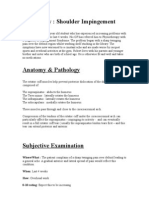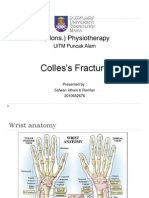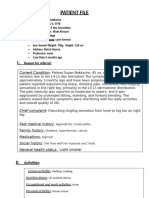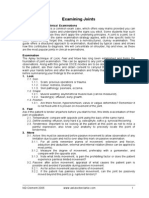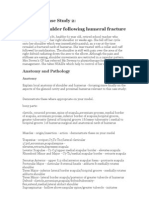0 ratings0% found this document useful (0 votes)
61 viewsSupervised Clinical Practice-III: Assignment
Supervised Clinical Practice-III: Assignment
Uploaded by
zainab siddique1) The document discusses several cases of upper limb soft tissue injuries and disorders, including a SLAP lesion, acromioclavicular joint separation, adhesive capsulitis, bicep rupture, and pronator teres syndrome.
2) Treatment plans focus on pain management, range of motion exercises, strengthening exercises, manual therapy, modalities like heat and ice, and education.
3) Specific treatments mentioned include rest, icing, stretching, strengthening, functional activities, and surgery in severe cases like bicep rupture.
Copyright:
© All Rights Reserved
Available Formats
Download as DOCX, PDF, TXT or read online from Scribd
Supervised Clinical Practice-III: Assignment
Supervised Clinical Practice-III: Assignment
Uploaded by
zainab siddique0 ratings0% found this document useful (0 votes)
61 views12 pages1) The document discusses several cases of upper limb soft tissue injuries and disorders, including a SLAP lesion, acromioclavicular joint separation, adhesive capsulitis, bicep rupture, and pronator teres syndrome.
2) Treatment plans focus on pain management, range of motion exercises, strengthening exercises, manual therapy, modalities like heat and ice, and education.
3) Specific treatments mentioned include rest, icing, stretching, strengthening, functional activities, and surgery in severe cases like bicep rupture.
Original Title
SCP Assignment
Copyright
© © All Rights Reserved
Available Formats
DOCX, PDF, TXT or read online from Scribd
Share this document
Did you find this document useful?
Is this content inappropriate?
1) The document discusses several cases of upper limb soft tissue injuries and disorders, including a SLAP lesion, acromioclavicular joint separation, adhesive capsulitis, bicep rupture, and pronator teres syndrome.
2) Treatment plans focus on pain management, range of motion exercises, strengthening exercises, manual therapy, modalities like heat and ice, and education.
3) Specific treatments mentioned include rest, icing, stretching, strengthening, functional activities, and surgery in severe cases like bicep rupture.
Copyright:
© All Rights Reserved
Available Formats
Download as DOCX, PDF, TXT or read online from Scribd
Download as docx, pdf, or txt
0 ratings0% found this document useful (0 votes)
61 views12 pagesSupervised Clinical Practice-III: Assignment
Supervised Clinical Practice-III: Assignment
Uploaded by
zainab siddique1) The document discusses several cases of upper limb soft tissue injuries and disorders, including a SLAP lesion, acromioclavicular joint separation, adhesive capsulitis, bicep rupture, and pronator teres syndrome.
2) Treatment plans focus on pain management, range of motion exercises, strengthening exercises, manual therapy, modalities like heat and ice, and education.
3) Specific treatments mentioned include rest, icing, stretching, strengthening, functional activities, and surgery in severe cases like bicep rupture.
Copyright:
© All Rights Reserved
Available Formats
Download as DOCX, PDF, TXT or read online from Scribd
Download as docx, pdf, or txt
You are on page 1of 12
Supervised Clinical Practice-III
Assignment
SUBMITTED TO: DR KINZA
SUBMITTED BY: ZAINAB SIDDIQUE
SAP#4002
7th semester(sec-B)
Upper limb soft tissue disorders
Case :SLAP Lesion
HISTORY: 27-year-old male complains of newly worsening left shoulder pain
after playing an intense basketball tournament over the weekend. He denies a
single incident that caused his pain and was able to finish playing the tournament.
Patient is a recreational basketball player and has a daytime desk job. He
complains of having pain while trying to sleep on the left shoulder, hence he only
slept on his right shoulder.
PHYSICAL EXAM: Physical examination revealed a slight loss of motion in the
left shoulder. No palpatory tenderness of the left shoulder was identified.
However, patient experienced pain with end-range abduction and flexion rotations
of the left shoulder.
TESTS & RESULTS: The patient was referred to a magnetic resonance imaging
(MRI) by an orthopedic surgeon. The MRI findings revealed a Superior Labrum
Anterior and Posterior (SLAP) lesion of the labrum. FINAL DIAGNOSIS: Left
shoulder labrum tear.
TREATMENT: After eight weeks of scapular stabilization, scapulo-thoracic
mobilization, and soft tissue mobilization treatments the patient showed a small
improvement;
Case : Acromioclavicular joint separation
41-year-old man is brought to the emergency department for evaluation of
a shoulder injury sustained as the result of a fall from his road bike. He denies loss
of consciousness, headache, neck or back pain, or other injury, and he reports that
he was wearing a helmet. The triage nurse comments that the shoulder looks
dislocated and asks if procedural sedation is needed.The patient’s vital signs are
normal.
Physical examination is normal except for an abrasion on the top of the shoulder
with visible deformity, tenderness, and guarding of the shoulder with limited range
of motion. His distal neurovascular examination is intact.
Treatment
Pain relief — Ice can help reduce pain from AC joint injuries, as the joint is close
to the skin. If needed, a non-prescription pain medication such as acetaminophen
(Tylenol), ibuprofen (eg, Advil, Motrin), or naproxen (eg, Aleve) can be taken.
Range-of-motion exercises — Range-of-motion exercises are recommended early
in the recovery period. These exercises are intended to help maintain joint mobility
and flexibility of the muscles and tendons in the shoulder.
Strengthening exercises — Muscle strengthening exercises are necessary to
improve shoulder muscle strength and help to prevent further injury.
Isometric exercises: should be multi-angle, submaximal and subpainful
1. Case :Adhesive Capsulitis
58 year old patient presented with Eight week history of left shoulder pain.
Insidious onset. Previously had frozen shoulder on his right four years ago.
Symptoms felt the same. Had failed physio/conservative management last
time and ended up having a manipulation under anaesthetic. Took a few
years to completely resolve, although MUA improved his movement
significantly. Worried he may have to go through the same with his left
shoulder. Aggravating factors Putting on a shirt Reaching for his wallet in
his back pocket ,Sleeping in any position at night , Reaching into cupboards.
Physical examination
During the initial assessment, he demonstrated restrictions when performing
shoulder abduction and flexion with a 50% limit in the range of motion
when compared to his right side. He also described pain scores during
shoulder abduction and flexion at a 5 out of 10 on the universal pain scale at
the end range of these movements and stated that his pain levels are at a
constant 3 out of 10 during his daily activities.
2. Case; Adhesive capsulitis
49 years old female presented with inability to lift arm above head level and
difficulty in activities like ,combing ,dressing, bathing etc due to shoulder pain.
HISTORY • Duration of symptoms : 3-4 months • Onset of symptoms: insidious
onset of pain and restriction of movements. • PAIN • Location : anterolateral arm
and shoulder • Quality : intermittent • Intensity : 6-7 on VAS • Aggravating factors
: Overhead activities, touching back , • Relieving factor : HWF
MEDICAL HISTORY • Diabetes • Hypertension • HISTORY OF TRAUMA
H/o fall or sudden jerk to the shoulder – absent
OBSERVATION
• Cervical spine : no forward head posture
• Shoulder : Normal
• Scapula : Normal ( not protracted or abducted)
• Thoracic spine : normal
• Lumbar : normal lordosis present
• Pelvis : no abnormal tilt
• Scapulohumeral rhythm: excessive scapular movements during elevation in
initial phase
INSPECTION & PALPATION
• Skin Color - normal , no signs of inflammation Scar – not present
• Soft tissue inspection Swelling- not present Muscle contours- normal when
compared with normal side.
• Gait - inadequate arm swing
• Attitude of affected upper extremity- arm by the side
• End feel : firm
MOBILITY Range of motion:shoulder Active range of motion Passive range of
motion Flexion 120 125° Extension 20 25 Abduction (frontal plane) 80° 90°
Elevation in scapular plane 110 120 External rotation with 0° abduction 10° 12°
Internal rotation with 90° abduction 25° 30°. CERVICAL MOTION Movements
Ranges Flexion 45° Extension 60° (Left )side flexion 40 (Right )side flexion 40
(Left ) rotation 70 (Right ) rotation 70
MANUAL MUSCLE TESTING •Shoulder muscle test in the available range
Muscle group Left shoulder (affected) Resisted isometrics (Affected) Right
shoulder (normal side) Flexors 3+ Painfree in neutral Painful in mid range 5
Extensor 4- Painfree Abductors 3+ Painful in middle range 5 Adductors 4+
Painfree 5 Horizontal adductors 4+ Painfree 5 External rotators 4- Painfree 5
Internal rotators 4 Painfree
Treatment PLAN of FROZEN SHOULDER
Your physical therapist's overall goal is to restore your movement, so you can
perform your daily activities. Once the evaluation process has identified the stage
of your condition, your physical therapist will create an individualized exercise
program tailored to your specific needs. Exercise has been found to be most
effective for those who are in stage 2 or higher. Your treatment may include:
Stages 1 and 2
Exercises and manual therapy. Your physical therapist will help you maintain as
much range of motion as possible and will help reduce your pain. use a
combination of range-of-motion exercises and manual therapy (hands-on)
techniques to maintain shoulder movement.
Modalities. may use heat and ice treatments (modalities) to help relax the muscles
prior to other forms of treatment.
Home-exercise program. give a gentle home-exercise program designed to help
reduce loss of motion.
Pain medication. Sometimes, conservative care cannot reduce the pain of
adhesive capsulitis. In that case, your physical therapist may refer you for an
injection of a safe anti-inflammatory and pain-relieving medication.
Stage 3
The focus of treatment during phase 3 is on the return of motion. Treatment may
include:
Stretching techniques. Your physical therapist may introduce more intense
stretching techniques to encourage greater movement and flexibility.
Manual therapy. Your physical therapist may take your manual therapy to a
higher level, encouraging the muscles and tissues to loosen up.
Strengthening exercises. You may begin strengthening exercises targeting the
shoulder area as well as your core muscles.
Stage 4
In the final stage, your physical therapist will focus on the return of "normal"
shoulder body mechanics and your return to normal, everyday, pain-free activities.
Your treatment may include:
Stretching techniques. The stretching techniques in this stage will be similar to
previous ones you’ve learned, but will focus on the specific directions and
positions that are limited for you.
Manual therapy.
Strength training. Your physical therapist will prescribe specific strengthening
exercises related to any weakness that you may have to help you perform your
work or recreational tasks.
Return to work or sport. Your physical therapist will address movements and
tasks that are required in your daily and recreational life.
Case : BICEP RUPTURE
26 yr old right hand dominated male presented to orthopedics department
presented to us with chief complains of swelling over his left mid and weakness of
his left arm after suffering an injury when his bike slipped and while falling down
in order to break the fall he tried to hold onto a metal post and his was subjected to
abduction and external rotation force 10 days back, Immediate pain and swelling
of the left upper arm and elbow region ensued.
Physical examination showed a linear sulcus like deformity over medial and mid-
portion of the patient’s upper arm and when the patient contracted his biceps, we
observed that the long head tendon remained intact and that a clearly defined bulge
had developed .Patient had retained its full motion in flexion and extension and
supination and pronation of the arm.HOOK test was performed and distal bicep
tendon was found intact.Sign of decreased muscle power was present. Magnetic
resonance image (MRI) studies suggested a partial muscle belly rupture through
the short head of the biceps with edematous fluid collection, leaving the long head
intact.
Treatment may include:
Rest. You will be instructed in ways that allows the limb to rest to promote
healing.
Icing. Your physical therapist will show you how to apply ice to the affected
area to manage pain and swelling.
Range-of-Motion Activities. ...
Strengthening Exercises. ...
Functional Activities. ...
Education.
Case :pronator teres syndrome
A 45-year old right-handed mechanic was presented to the OPD with a 6-month
history of left forearm pain, numbness and weakness in gripping with thumb and
index finger. Sensation was reduced over median nerve distribution. He was
unable to flex thumb interphalangeal joint , index finger , and unable to perform
“OK” sign. Pain was aggravated by active pronation against resistance. Nerve
conduction study was normal.
Treatment may include manual therapy techniques (trigger point therapy and
deep tissue massage), offer advice regarding temporary offloading of the muscles
and methods to specifically target the region to build strength and resilience,
ultimately to restore normal physiology and mitigate compression on the median
nerve .
Case: supinator syndrome
A 58-year-old right-handed man came to our clinic complaining of progressive left
finger drop over the previous 3 to 4 months. He had no history of trauma or
repetitive upper arm activities, nor did he have any neck, shoulder, or upper limb
pain. His medical history included type 2 diabetes mellitus, hypertension, and
dyslipidemia. Family history yielded no relevant details.
physical examination, he had full muscle strength for flexion in the left fingers
and wrist; however, the muscle strength for extension of the left wrist was grade 4
with radial deviation and the muscle strengths for extension of the left second,
third, fourth, and fifth fingers were grades 2, 2, 0, and 0, respectively. No obvious
muscle atrophy or sensory impairment was found. The deep tendon reflexes of the
biceps, brachioradialis, and triceps were normal. The Spurling test was negative.
Cervical spine X-ray and magnetic resonance imaging showed mild foraminal
narrowing at the left C3/4 level, mild spinal stenosis at the C3-T1 levels without
obvious root or cord compression, and imaging of the roots showed no signs of an
inflammatory disorder. Electrodiagnostic testing revealed normal conduction
velocity with low-amplitude compound muscle action potential without
conduction block between forearm and elbow in a left radial motor study, and
superficial radial sensory tests were normal. In addition, no evidence of conduction
block was found in other arm nerves.
TREATMENT:
Physiotherapy should include a multimodal approach. The following can be
considered based on the patient presentation:
Cryotherapy: Increase extensibility and reduce tone of local muscles
Ultrasound
TENS
Deep tissue massage and stretching exercises: Improve extensibility of the muscles
who surround the brachial plexus and radial nerve.
Case: Olecranon bursitis
A 54-year-old male bartender presents with posterior elbow pain that has been
present for the past 2 weeks. The patient complains of dull pain with difficulty
bending and straightening the elbow for dressing activities and weakness with
pushing heavy items at work. He has marked pain when leaning his weight on his
elbow when bent, especially on hard surfaces. The patient has focal swelling at the
posterior elbow over the olecranon, which he notes varies in size when he leans on
his elbow at work. The patient has had plain film x-rays which were negative for
fracture.
Treatment :
Apply RICE method : Rice stands for Rest, Ice, Compression and
Elevation.
Phonophoresis, electrical stimulation : helpful for reducing pain and
inflammation.
Elbow extension stretch
1. Case :De Quervain’s Tenosynovitis:
a 48 year old right handed community physiotherapy assistant, attends your GP
practice. She complains of a 2 week history of right wrist pain. On further
consultation she indicates that she had just put together a large number of
information packs at work with repeated use of a stapler and feels this caused her
wrist pain. Her job usually involves assisting patients undergoing physiotherapy
and she says that this does not involve such repetitive use of her wrist.
On assessment you note that she has a positive Finklestein's test.
2. Case 2
A 23-year-old male weightlifter player presented complaining of right-sided
wrist and thumb pain at the base of the styloid of the radius while doing
twisting movement of wrist and lifting activities. Player reported that his pain
started 2 month ago which increased gradually during training sessions of weight
lifting. His pain was worst since 2 days when he reported to Physiotherapy OPD
which affected wrist, hand and thumb activities.
On pain assessment (Visual Analog Scale) VAS during training session was 8
out of 10 and VAS at rest was 2 out of 10. The pain was constant, dull in nature
and increased during continued practice, pinching, griping and weight lifting
activities.
On observations his built was endomorphic, fusiform swelling was seen over
radial styloid process, muscles wasting was not present and any deformity was not
present. There was no Bruising and Echymosis. On palpation the patient
reported tenderness grade 2nd (Anatomical snuffbox), temperature was
slightly increased), crepitus was absent, skin texture was normal and muscles
spasm was not present.
Active Ranges of motion and resisted isometric contraction of the right wrist
revealed painful and resisted at wrist flexion and radial deviation at end
range. Thumb ranges of motion on the right revealed painful active and resisted
abduction, extension, opposition
Diagnosis test: A Finkelstein's Test positive.
GOAL OF TREATMENT
Short term : to Reduce Pain , Reduce swelling ,Protection with wrist band
,Increase R.O.M
Long term: to improve Strengthening of muscles around wrist joint muscles
and thumb muscles Extensor- extensor pollicis longus, extensor pollicis brevis,
1st dorsal interrosei Flexor – flxor carpi ulnaris, flexor carpi brevis, flexor
carpi radialis Thumb- abductor pollicislongus, abductor pollicis brevis,
adductor pollicis ,Home exercise Program, Return to the game.
1. Case :Rotator cuff impingement
67 year old patient presented with complain of shoulder pain and inability to fully
lift up his Lt sh. and on overhead movement also Claim had difficulty removing
shirt and inability lift heavy. Pt had Lt sh. pain since past 6/12 after knitting fruit.
The pain gradually increase and pt referred dr.as the pain became unbearable. Pt
then referred to do physiotherapy. DM since past 2 yrs ,Medication : HPT and DM
medication.
Pain Assessment
Area : ant. aspect of Lt. sh.
Nature : throbbing, catching pain
Agg. : Lift hand >90deg, remove off shirt, carry heavy objects >5kg, Depend on
activity, more pain at night if sleep on Lt. sd. but not disturbing sleep
Ease : Rest, hand in normal position:
Irritability : non-irritable (pain will subside immediately after agg. factor
removed )
Severity : not severe
OBJECTIVE ASSESSMENT :
Observation
Pt medium height came into dept. with normal gait.
Posture : - Slightly kyphotic - ears slightly anterior than shoulder - Lt. Sh. and
scapula lower than Rt. - No winging of scapula –
Pelvic same level - Kn. same level
Inspection:
No swelling, redness at shoulder region
Palpation
Muscle spasm noted on Lt upper trapezius
Pain on palpation over biceps long head, supraspinatus and subscapularis tendon.
SPECIAL TEST : Neer’s test: +ve indicate impingement Hawkin Kennedy :
+ve indicate impingement Speed test : +ve indicate bicipital tendinitis
Empty can test: +ve indicate supraspinatus tendinitis Anterior drawer test : -ve
Posterior drawer test : -ve
Treatment goals:
SHORT TERM GOAL
To reduce pain
To improve ROM
To increase muscle power
To reduce upper trap muscle spasm
LONG TERM GOAL
To maximize functional activity of daily living
To prevent secondary complication
2. CASE 2:
63 years old Female presented with CHIEF COMPLAINT of pain at her
leftshoulder when lifting up the left hand above the headlevel and try to lift heavy
things. Patient also complain difficulty in dressing especially when trying to wear
braand take out her cloth.Patient had fall down about 4 weeks agodue to wet floor
at a bank. She fall with outstretched lefthand. She only felt pain after 3 days prior
to the injury. She went to traditional Chinese doctor and did massage but the pain
became worse.then she referred to physiotherapy.she also have High blood
pressure and depression .Patient taking medication of high blood pressure and
Lexapio 5mg 2 tablet per day for depression.
Pain assessment Site : Anterior and posterior shoulder near to glenohumeral joint
Pain scale :4/10 when rest6/10 when lift up the hand above head level and carry
heavy things ,Nature of pain : Pulling pain, Aggravating factor : Lift up the hand
above head level and carryheavy things, Easing factor : Resting hand on the
abdomen in internal positionof shoulder, Irritability : Medium24 hours :am : No
painpm : sometime disturb sleep, Onset : Gradual
On observation- Body built : Medium- Deformities : NIL-
On inspection: Swelling : mild swelling around the left shoulder- Posture :
Slightly kyphotic
On palpation- Spasm : on the anterior and posterior part of leftshoulder- Warmth :
no- Tightness : on anterior part of left shoulder
On examination (Range of motion )1) Shoulder*( )-degree where patient start feel
painpatient feel pain when do the flexion, extension, abduction and medialrotation
of left shoulder.
Special Test :Neer Impingement Test Negative, Hawkins-kennedy Impingement
Test Negative, Empty Can Test Positive.
Plan of treatment- Pain relief- Soft tissue manipulation- Home program exercise-
Patient education
Short Term Goal-
To reduce pain at the left shoulder-
To increase range of motion of flexion, extension, abduction and
medialrotation of left shoulder-
To Improve the muscle power of left shoulder
Long Term Goal-
To improve functional activity of daily life ( patient can able to do
housework with no pain )
To prevent secondary complication
You might also like
- Shoulder Case Study 1Document4 pagesShoulder Case Study 1superhoofy718667% (3)
- Frozen Shoulder - Adhesive Capsulitis - OrthoInfo - AAOSDocument6 pagesFrozen Shoulder - Adhesive Capsulitis - OrthoInfo - AAOSpempekplgNo ratings yet
- Posterior Dislocation of The Shoulder 1Document5 pagesPosterior Dislocation of The Shoulder 1sdylhnaysh39No ratings yet
- Colles's Fracture: B (Hons.) PhysiotherapyDocument36 pagesColles's Fracture: B (Hons.) PhysiotherapySafwan Idham RamlanNo ratings yet
- Anterior Shoulder Pain: What Questions Would You Ask in The Subjective Examination?Document3 pagesAnterior Shoulder Pain: What Questions Would You Ask in The Subjective Examination?Kanwal KhanNo ratings yet
- Keeping Your Shoulders HealthyDocument38 pagesKeeping Your Shoulders Healthyxyz84No ratings yet
- Taping and Bandaging ReportDocument7 pagesTaping and Bandaging ReportA.M.A AlshehriNo ratings yet
- I. Etiology Primary Adhesive Capsulitis Secondary Adhesive CapsulitisDocument8 pagesI. Etiology Primary Adhesive Capsulitis Secondary Adhesive CapsulitisVanessa Yvonne Gurtiza100% (1)
- Frozen ShoulderDocument18 pagesFrozen ShoulderChitra ChauhanNo ratings yet
- Assignment For IqraDocument3 pagesAssignment For IqraitsseemabkhanNo ratings yet
- Rotator Cuff Report FinalDocument5 pagesRotator Cuff Report FinalLuis EchevarriaNo ratings yet
- Ankylosing SpondylytisDocument6 pagesAnkylosing SpondylytisMurad KurdiNo ratings yet
- Patient Fil1Document7 pagesPatient Fil1lynnxam1No ratings yet
- Case 2Document19 pagesCase 2jagdish030798No ratings yet
- Ankylosing SpondylitisDocument31 pagesAnkylosing SpondylitisArathy100% (1)
- Shoulder Pain-Pemalang 18 Des 22Document65 pagesShoulder Pain-Pemalang 18 Des 22yaang yuliana ciptaNo ratings yet
- Anamika 1Document20 pagesAnamika 1Aayushi SrivastavaNo ratings yet
- PIVDDocument18 pagesPIVDAayushi SrivastavaNo ratings yet
- The Components of An Objective ExaminationDocument8 pagesThe Components of An Objective ExaminationShiza ShirazNo ratings yet
- Musculo Skeletal AssessmentDocument4 pagesMusculo Skeletal Assessmentsriram gopalNo ratings yet
- Frozen ShoulderDocument5 pagesFrozen ShoulderRodrigoNo ratings yet
- MSK 2 Case StudyDocument8 pagesMSK 2 Case StudyYumi KaitoNo ratings yet
- Mod8 - Activity 2 - Clinical Case StudyDocument3 pagesMod8 - Activity 2 - Clinical Case Studycoupfrank.podcastNo ratings yet
- Case ReportDocument13 pagesCase Reportapi-676777659No ratings yet
- Lower Crossed SyndromeDocument8 pagesLower Crossed SyndromeThaseen75% (4)
- Frozen Shoulder ExercisesDocument7 pagesFrozen Shoulder ExercisesSumon PhysioNo ratings yet
- Adhesive Capsulitis or Frozen SholderDocument24 pagesAdhesive Capsulitis or Frozen Sholdersanalcrazy100% (1)
- Shoulder Range of Motion Exercises PDFDocument4 pagesShoulder Range of Motion Exercises PDFGade JyNo ratings yet
- Daftar Tilik APNDocument17 pagesDaftar Tilik APNmarindadaNo ratings yet
- 02.elbow PainDocument62 pages02.elbow PainKhushboo IkramNo ratings yet
- Assessmentofshoulder 180107041721Document36 pagesAssessmentofshoulder 180107041721Chandra PrabhaNo ratings yet
- Lumbar Strain: Dr. Lipy Bhat PT Faculty, Physiotherapy SrhuDocument38 pagesLumbar Strain: Dr. Lipy Bhat PT Faculty, Physiotherapy SrhuKapil LakhwaraNo ratings yet
- Management of Elbow Common Injuries: Functional Anatomy Mechanics Epicondylitis Post Immobilization Capsular TightnessDocument31 pagesManagement of Elbow Common Injuries: Functional Anatomy Mechanics Epicondylitis Post Immobilization Capsular TightnessAmany Abd ELfatah HassanNo ratings yet
- Case ReportDocument14 pagesCase Reportapi-678217089No ratings yet
- Frozen Shoulder: By: Kanchan SharmaDocument21 pagesFrozen Shoulder: By: Kanchan SharmaKanchan SharmaNo ratings yet
- Cervical Spondylosis With RadiculopathyDocument26 pagesCervical Spondylosis With RadiculopathyKashish SahotaNo ratings yet
- Examining Joints: How To Succeed in Clinical ExaminationsDocument12 pagesExamining Joints: How To Succeed in Clinical ExaminationsimperiallightNo ratings yet
- Exercise TherapyDocument15 pagesExercise TherapyKathal 66No ratings yet
- MSK Clinical Reasoning Form - Placement 4Document6 pagesMSK Clinical Reasoning Form - Placement 4machmouchilynn5No ratings yet
- Frozen ShoulderDocument6 pagesFrozen ShoulderanumolNo ratings yet
- Mitland For Cevical SpineDocument52 pagesMitland For Cevical SpineMohamed RamadanNo ratings yet
- Case Report Rehabilitation Program in A Patient With Bilateral Arthroplasty For Hip OsteoarthritisDocument26 pagesCase Report Rehabilitation Program in A Patient With Bilateral Arthroplasty For Hip OsteoarthritisNatalia LoredanaNo ratings yet
- Physical Therapy in Lumbar SpineDocument12 pagesPhysical Therapy in Lumbar SpineMarcos Perez Albert100% (1)
- Old Chronologically and Cognitively, But at A 6-Month-Old Gross Developmental Level Would IncludeDocument20 pagesOld Chronologically and Cognitively, But at A 6-Month-Old Gross Developmental Level Would IncludebayanalshikaliNo ratings yet
- Lower Back SpondylosisDocument4 pagesLower Back SpondylosisDiduNo ratings yet
- Case Report Rehabilitation Program in A Patient With Femoral Neck FractureDocument26 pagesCase Report Rehabilitation Program in A Patient With Femoral Neck FractureNatalia LoredanaNo ratings yet
- TM Shoulder Exam-1Document36 pagesTM Shoulder Exam-1ratkhiaberNo ratings yet
- MSK Case Cervical Radicular SyndromeDocument5 pagesMSK Case Cervical Radicular SyndromesohilaNo ratings yet
- ClinicalDocument7 pagesClinicalNaila AfzalNo ratings yet
- Topic - : Evidence Based PT Management of Periartheritis ShoulderDocument23 pagesTopic - : Evidence Based PT Management of Periartheritis ShoulderAYUSH SINGHYTNo ratings yet
- Adcap Case Pre OrigDocument38 pagesAdcap Case Pre OrigEloisaNo ratings yet
- Exercise 1: CHIR12007 Clinical Assessment and Diagnosis Portfolio Exercises Week 7Document4 pagesExercise 1: CHIR12007 Clinical Assessment and Diagnosis Portfolio Exercises Week 7api-479717740No ratings yet
- Manual Reduce Pain and Strengthen Your Lower Back With These Easy TipsDocument19 pagesManual Reduce Pain and Strengthen Your Lower Back With These Easy Tipschris.frost105No ratings yet
- Rotator Cuff TendinitisDocument23 pagesRotator Cuff TendinitisVrushali NikamNo ratings yet
- Shoulder Case Study 2Document5 pagesShoulder Case Study 2superhoofy7186No ratings yet
- CASE PRESENTATION ON FROZEN SHOULDER AFTER STROKEDocument39 pagesCASE PRESENTATION ON FROZEN SHOULDER AFTER STROKEdrkhushboosharmaphysioNo ratings yet
- Lumbar Disc HerniationDocument8 pagesLumbar Disc Herniationandra_scooterNo ratings yet
- Run With No Pain: A Step-by-Step Exercise Solution for Eliminating Low Back Pain in AthletesFrom EverandRun With No Pain: A Step-by-Step Exercise Solution for Eliminating Low Back Pain in AthletesNo ratings yet
- The Whartons' Strength Book: Upper Body: Total Stability for Shoulders, Neck, Arm, Wrist, and ElbowFrom EverandThe Whartons' Strength Book: Upper Body: Total Stability for Shoulders, Neck, Arm, Wrist, and ElbowRating: 5 out of 5 stars5/5 (1)
- Holistic Home Remedies for Acute Low Back Pain: Incorporating Stretching and the McKenzie MethodFrom EverandHolistic Home Remedies for Acute Low Back Pain: Incorporating Stretching and the McKenzie MethodNo ratings yet
- Imaging of Chronic Non-Traumatic Shoulder Pain: Dr. Naveed Ahmed Fcps FRCRDocument70 pagesImaging of Chronic Non-Traumatic Shoulder Pain: Dr. Naveed Ahmed Fcps FRCRNaveed AhmedNo ratings yet
- Trauma Lecture 7Document61 pagesTrauma Lecture 7The bella GirlNo ratings yet
- Mulligan PDFDocument6 pagesMulligan PDFAlexandru IordacheNo ratings yet
- Pain Motion and Function CompDocument12 pagesPain Motion and Function CompDewi HanaNo ratings yet
- Frozen ShoulderDocument18 pagesFrozen ShoulderChitra ChauhanNo ratings yet
- Differential Diagnosis of Shoulder RegionDocument96 pagesDifferential Diagnosis of Shoulder RegionZuhaib AhmedNo ratings yet
- Throwing BiomechanicsDocument7 pagesThrowing Biomechanicsarold bodoNo ratings yet
- Arthroscopic Treatment of Internal Impingement: Matthew T. Boes, Craig D. MorganDocument15 pagesArthroscopic Treatment of Internal Impingement: Matthew T. Boes, Craig D. MorganJaime Vázquez ZárateNo ratings yet
- Shoulder Joint: Importanat Notes With Special TestsDocument3 pagesShoulder Joint: Importanat Notes With Special TestsGhica CostinNo ratings yet
- Penatalaksanaan Fisioterapi Pada KasusDocument8 pagesPenatalaksanaan Fisioterapi Pada KasusWidya SyahdilaNo ratings yet
- Articicol Ecografie UmarDocument25 pagesArticicol Ecografie UmarluizamgoNo ratings yet
- Red Flag: MSK Services Pathway - Shoulder PathologyDocument11 pagesRed Flag: MSK Services Pathway - Shoulder PathologyMuhammed ElgasimNo ratings yet
- Shoulder Pain e-chart Quick reference guide (HC-HealthComm)Document15 pagesShoulder Pain e-chart Quick reference guide (HC-HealthComm)benanimNo ratings yet
- Cools 2008 Screening The Athletes Shoulder ForDocument9 pagesCools 2008 Screening The Athletes Shoulder ForLucyFloresNo ratings yet
- Dynamic Neuromuscular Stabilization & Sports RehabilitationDocument13 pagesDynamic Neuromuscular Stabilization & Sports RehabilitationHONGJYNo ratings yet
- Technique Correction For Upright RovingDocument15 pagesTechnique Correction For Upright RovingEberlin TadNo ratings yet
- Anterior Achromioplasty For The Chronic Impingement Syndrome in The ShoulderDocument1 pageAnterior Achromioplasty For The Chronic Impingement Syndrome in The ShoulderJefferson James Dos SantosNo ratings yet
- Glenohumeral JointDocument85 pagesGlenohumeral JointPoojitha reddy MunnangiNo ratings yet
- Magee HipDocument45 pagesMagee HipDevsya DodiaNo ratings yet
- DNS PDFDocument12 pagesDNS PDFMaksim BogdanovNo ratings yet
- Clinical Tests For Evaluation of Motor Function of The ShoulderDocument10 pagesClinical Tests For Evaluation of Motor Function of The ShoulderNader AlkhateebNo ratings yet
- Sports Injury: High Yield FactsDocument27 pagesSports Injury: High Yield FactsskNo ratings yet
- Shoulder Impingement SyndromeDocument17 pagesShoulder Impingement SyndromeILR 2019No ratings yet
- Swimmers ShoulderDocument26 pagesSwimmers ShoulderThunder CrackerNo ratings yet
- Sports Medicine Scored and Recorded Self-Assessment ExaminationDocument71 pagesSports Medicine Scored and Recorded Self-Assessment ExaminationZia Ur RehmanNo ratings yet
- 2022 Chiou Tan Musculoskeletal Mimics of Cervical RadiculopathyDocument9 pages2022 Chiou Tan Musculoskeletal Mimics of Cervical RadiculopathyIsadora GarciaNo ratings yet
- Willmore, 2016 - Scapular Dyskinesia (Evolution Towards A Systems Based Approach)Document10 pagesWillmore, 2016 - Scapular Dyskinesia (Evolution Towards A Systems Based Approach)Ana Teixeira MartinsNo ratings yet
- 2011 Jeremy Lewis Subacromial Impingement SyndromeDocument11 pages2011 Jeremy Lewis Subacromial Impingement Syndromepuntocom111No ratings yet
- Pecial Tests of Shoulder Joint: Aarti Sareen MSPT-I Semester (Honours)Document33 pagesPecial Tests of Shoulder Joint: Aarti Sareen MSPT-I Semester (Honours)Orlando NuhoNo ratings yet
- Get Curbside Consultation of the Shoulder 49 Clinical Questions First Edition Nicholson Md PDF ebook with Full Chapters NowDocument75 pagesGet Curbside Consultation of the Shoulder 49 Clinical Questions First Edition Nicholson Md PDF ebook with Full Chapters Nowerkeshkemgmo100% (9)
